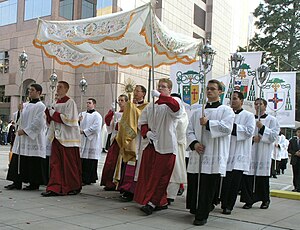Holy of Holies (Christianity)
As the most holy place , even sanctum sacrament (of the altar) or (sanctum) Sacrament (, lat. Sanctissimum [Sacramentum] ) is called in the Roman Catholic Church in the Holy Mass consecrated gifts of bread and wine, in which Christ after Church teaching is truly and permanently present ( transubstantiation ). While the wine is always drunk in the liturgy of mass, consecrated hosts are kept in the tabernacle as the holy of holies and are used for communion for the sick and dying ( food for the journey ) as well as for adoring veneration by the faithful.
Keeping the Holy of Holies
The holy of holies is kept in a ciborium or a pyxis , the large host for the veneration of the holy of holies is also kept in a custodia in the tabernacle of a church or chapel, which must be specially secured because of the risk of profanation of the wafers. When the Holy of Holies is in the tabernacle, the eternal light burns nearby . Pyxis is also used to bring the Holy of Holies to the sick to give communion. The consecrated hosts have been kept in the tabernacle since ancient times because of the communion of the sick and for the donation of food for the journey on days when no Holy Mass is celebrated ( Good Friday and Holy Saturday ) .
Adoration of the Holy of Holies

The veneration of the holy of holies is derived from the piety of the mass and did not arise until the High Middle Ages. At its center is the veneration of the incarnate Son of God in the form of bread, which was influenced by a strong emphasis on the real presence in connection with a high mediaeval piety determined by the desire to look at the Eucharist. Adoration of the Eucharist is not the reason for keeping the Holy of Holies after Holy Mass, but its consequence. The forms of worship have become a characteristic of the Western Church .
The tabernacle with the Holy of Holies is always a place for silent adoration in a church ; daily opening times of the church are desirable for this. The traditional “visitation of the Holy of Holies” (visitatio Sanctissimi) is understood as “prayer before the Most Holy Sacrament”, as a grateful response to the encounter (communio) with God given during Holy Mass .
The most holy of holies is traditionally worshiped by a squat when walking past the tabernacle, a double knee bend in front of the exposed holy of holies or by kneeling down when worshiping and giving blessings.
Exposure of the holy of holies and sacramental blessings
In the exposition of the Blessed (Exposure) sets in priest , deacon or acolyte the consecrated host in a special container, usually in a monstrance (of lat. Monstrare , "show"), in a Custodia or with the Ziboriumvelum covered ciborium on the altar, so that the most holy of holies can be venerated by the faithful in common prayer or in silent adoration. Any consecrated host can be used, but celebrations that are particularly large or decorated with an embossed image are usually exposed. The suspension means an extension of the elevation , the showing of the body and blood of Christ while walking in the Holy Mass . Baroque altars had an exposure niche above the tabernacle to accommodate the monstrance with the holy of holies.
Mostly at the end of prayer times before the exposed Blessed Sacrament, the priest or deacon gives the sacramental blessing in the form of a cross with the Blessed Sacrament, also at the end of Eucharistic processions.
Eucharistic procession
In a Eucharistic procession or sacrament procession , the Holy of Holies is often carried forward by a priest or deacon walking in the monstrance under a canopy called "heaven". The holy of holies forms the center of the procession and is accompanied by candlesticks and incense holders . The procession is to take place after a holy mass, in which the host for this procession was also consecrated. At one or more stations - also called " altars " - the sacramental blessing is given with the holy of holies.
literature
- Werner Groß (ed.): Whoever believes worships. Corpus Christi - Adoration of the Eucharist . Schwabenverlag, Ostfildern 2000, ISBN 3-7966-0977-5 , esp. Pp. 32–34 (Forms of Eucharistic Adoration).
- Hans Bernhard Meyer : Eucharist: History, Theology, Pastoral . Pustet, Regensburg 1989, ISBN 3-7917-1200-4 (Church service. Handbook of liturgical science, part 4), pp. 580–602 (Storage and adoration of the Eucharist).
Individual evidence
- ↑ Codex Iuris Canonici (CIC) Canones 935-944 .
- ^ Hans Bernhard Meyer: Eucharist. History, theology, pastoral care; Church service. Handbook of liturgical science, part 4. Regensburg 1989, ISBN 3-7917-1200-4 , pp. 580-583.
- ^ Congregation for Rites - Consilium : Instructions on the celebration and veneration of the Eucharist “Eucharisticum mysterium” (May 25, 1967). In: AAS 59, 1967, pp. 539–573, here No. 50, after Hans Bernhard Meyer: Eucharistie. History, theology, pastoral care; Church service. Handbook of liturgical science, part 4. Regensburg 1989, ISBN 3-7917-1200-4 , p. 597.
- ^ Hans Bernhard Meyer: Eucharist. History, theology, pastoral care; Church service. Handbook of liturgical science, part 4. Regensburg 1989, ISBN 3-7917-1200-4 , p. 595.
